Part 30: Epilogue – 1444
Chapter 30 – Epilogue – A Short Summary of CK2845 AH, Qadis
Sultan Sayf was dying. His nights were spent suffering through wracking coughs and uncontrollable convulsions, and every morning saw him weaker than the last. He didn’t dare summon his physicians, he knew full well that he didn’t have much time left, and they would probably just make it worse.
Swallowing the lump in his throat, the sultan laboriously pushed himself off his bed and staggered his way to the nearby desk, collapsing into the ornate armchair behind it. After taking a few moments to catch his breath, Sayf leaned forward and clasped the leather-bound journal that was resting against the scented wood.
The leather was supple and aged, the paper flaky and scabrous, but that little book was the single most valuable possession that he had. And seeing as he was the Sultan of Al Andalus, that was saying something.
Decades in the making and spanning centuries of history, the Chronicles of Al Andalus was a collection of personal writings, posthumous biographies, historic letters and flowery poetry that all came together to record the long reign of the Jizrunids thus far.
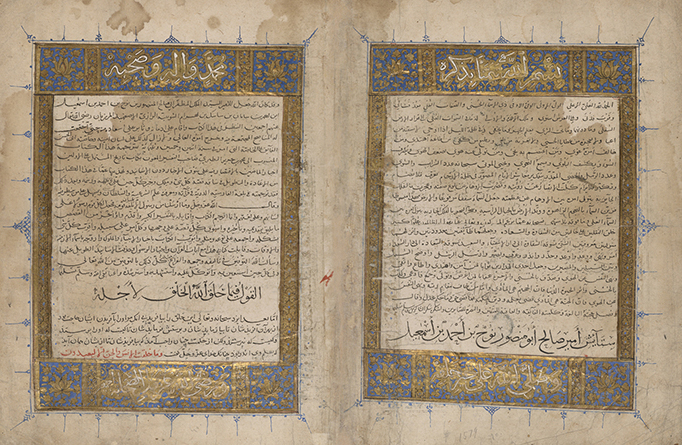
Sayf had spent years collecting the letters, books and manuscripts that formed the semi-coherent narrative, and seeing it complete was his proudest achievement.
The dying sultan cautiously peeled the front cover of the journal open, running his eyes over the first entry - a marriage contract that dated all the way back to a Sheikh Muhammad, who had ruled Qadis when it was nothing but a small and unimportant fishing village.
There wasn’t too much on Muhammad, he led a wholly unremarkable life, and died a few short years after inheriting the sheikhdom.

There was no shortage of material on the next Jizrunid ruler, however, Sheikh Az’ar was a shamefully common character in children’s stories and scholarly histories alike.
Contemporary writers swore that Az’ar was Shaitan incarnate, that he was evil personified, nothing short of a devil with great horns curving from his brow, red eyes that constantly glimmered and a black heart that didn't beat. Sayf leafed through the next few pages, which were full of anti-Jizrunid rhetoric, with countless scholarly publications denouncing Az’ar as a ‘Son of Satan’, encouraging the populace to rise up in revolt and depose him.
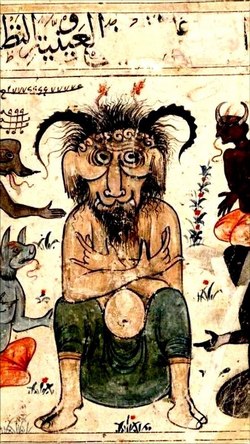
Perhaps inevitably, Azar’s death arrived rather abruptly, his life cut short in an ‘accident’. To put it bluntly, it would seem he was killed in the act of lovemaking, by none other than the young mistress who shared his bed. Not the best way to go, needless to say.

These accidents would quickly become a recurring theme throughout Jizrunid history, unfortunately. In fact, Azar’s own son, Masud the Unfortunate, would die a hideous cripple a scant few years later.

Every now and then, however, there was a Jizrunid who managed to shine. After a scattering of medical entries detailing Masud’s extensive injuries, entire pages of the book were dedicated to Emir Galind, who’d become something of a storybook legend over the centuries.
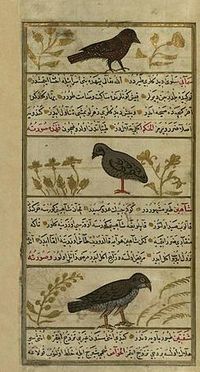
Dubbed the ‘Kingkiller’ throughout his long life, Galind was widely regarded as the first Sultan of a truly revived Al Andalus, having defeated an array of Christian powers in a succession of wars. He threw back a dangerous Aragonese invasion, conquered vast tracts of land from the Kingdom of Portugal, recaptured the historic city of Qurtubah - and, as his nickname implies, cut down a fair few kings in the process.

Another racking cough suddenly overwhelmed the sultan, who clamped his arm against his mouth to shield his precious book. When the coughs finally subsided a few painful minutes later, Sayf’s sleeves came away drenched in blood. It was becoming more common, but the sultan didn’t even blink, his attention quickly shifting back to his treasured tome.
Sayf carefully thumbed past a few more pages, which recorded the reign of Sultan Fath, who'd managed to repel the First Crusade for Al Andalus. A great achievement, but Fath would not be justly rewarded for it, not by a long shot. Not only did an operation gone awry claim his manhood, but the Sultan was brutally assassinated a few years later, cut down in the middle of his own palace.

After staring at a dry, flaky painting of Fath for a few minutes longer, Sayf moved on, skimming past the short reigns and unfortunate ends of Utman and Abdul-Hasan, both of whom led relatively inconsequential lives and shared equally-bloody deaths.


When he reached a tattered painting of a regal man atop his throne, however, Sayf came to a halt. Hakam the Reformer was a famous man, still revered by writers and poets today, despite the infamous suicide that closed his reign.

His years in power were widely-regarded as the zenith of medieval Jizrunid power, having witnessed the tolerance and leniency of minorities and heretics, championed patience and magnanimity between bitterly-divided peoples, supported a flourishing of culture and arts throughout the peninsula…

... Only to be succeeded by the horrifying, devastating years of the Black Death. Slashing the population of Iberia by hundreds of thousands, catalysing a succession of bloody civil wars, sending entire kingdoms into crushing debt and unrest, inciting the assassination of countless sultans and emirs…

The effects of the Great Leveller were still being felt all across the world, of that much there was no doubt.
If anything, however, the Andalusi were a persistent people. Sultan Sayf felt the corners of his mouth tugging into something eerily close to a smile as he leafed through a few more pages, which were full of verses and balladry praising the exploits of Ayyub al-Ansar, who was the first Jizrunid sultan to defeat the Roman Empire in open battle, only to be brought low when he was captured and castrated by Italian partisans.

After thumbing past a crude drawing of a coin bearing Ayyub's likeness, Sayf slowed down, thumbing through dozens of pages dedicated solely to beautiful, heart-wrenching, ambitious poetry. As the pages turned and years flew past, however, they gradually began to morph into something much, much darker, something angry at the world and its creator. These were the personal writings of the Mad King, the Lunatic, the Pagan-Sultan, the man who plunged Al Andalus into civil war and was slain by his bastard half-brother.

The years following the rule of the Mad King tell a story of a divided Al Andalus, one in which the rift between the Sultan and his vassals only become wider, culminating in countless uprisings and rebellions. These internal conflicts characterised the reigns of the next sultan, Ayyub the Good, whose heart gave out after Qadis itself was besieged in the Second Crusade for Al Andalus.

His successor, however, managed to piece the realm together again. Nicknamed Sayfullah, or the Sword of Allah, Sultan Ma’n reunified Al Andalus by focusing his efforts on external wars, dedicating his life to bloody campaigns in Sicily and the Holy Land. His most famous act would be the public execution of the Bishop of Rome, in his very own streets, before a thronging crowd of Christian-faithful and Muslim invaders.
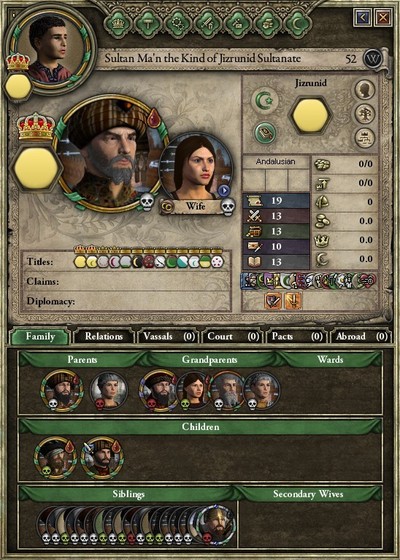
Crisp letters, archaic edicts, flattering paintings and poetry took up the next few pages before the entries came to a sudden, abrupt end. At the top of the final page was Sayf’s name, penned down in calligraphic script, but with nothing written below it. For a brief moment, the sultan wondered what stories his page would tell a few years later, when he was dead and buried and gone from this world.

But then the cough came back, and the Sultan collapsed onto his marble floors, his heart hammering against his chest. Once the painful convulsions came to an end, the young man pushed himself up from the blood-spattered rug, onto his knees, then onto his feet. He wanted nothing more than to curl up and sleep forever, but he was still a sultan, and a sultan did not embrace death willingly.
Instead, he reached over his desk and plucked his journal up, carefully tying the brittle leather cords shut. He then turned around and shuffled his way towards the balcony, desperate for some wind and air to clear the stench of iron.
Outside, a red sun stretched across the vast sky and a cool breeze wafted towards the balcony. Just beyond the parapets, Qadis stretched out into the horizon to create a magnificent view of a city on the rise, home to thousands of mansions and houses and hovels, to hundreds of mosques and churches and shrines, to countless piercing minarets, crenellated arches, and honeycomb domes. The ancestral seat of the Jizrunids had grown far beyond the thatched fences and wooden portcullises that once bound it against the sea.
After taking in the view for a few moments more, Sultan Sayf turned around and hobbled back into his dark rooms. He would not see out the night, but the city behind him would continue to prosper and grow, one day to become the very centre of the world.
-- -- --
The world of 1444, after border adjustments:
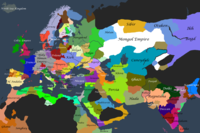
The world of 1444, before border adjustments:
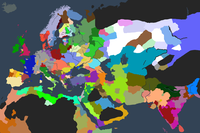
I swapped a few provinces around, got rid of a bunch of OPMs, and released a couple powerful vassals where it made sense. There's still going to be a few changes, but that's probably going to be what EU4 looks like.